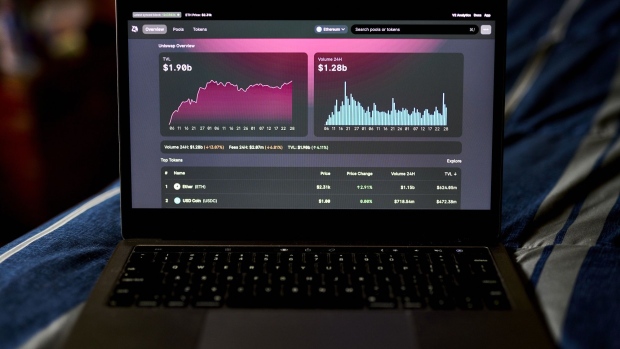May 5, 2022
DeFi Exchange Says It Beats Larger Rivals Binance, Coinbase
, Bloomberg News

(Bloomberg) -- Uniswap, the biggest decentralized crypto exchange, says that it can provide more liquidity than its larger, centralized rivals Coinbase and Binance, because of the incentives it gives its liquidity providers to deliver better pricing to traders.
Compared to the most popular Ether trading pairs on the centralized exchanges, the latest version of Uniswap launched about a year ago allows traders to execute large-size trades in a price range they prefer more easily, new research by Uniswap Labs, the main developer of the exchange, found. Coinbase and Binance did not respond to requests for comment.
The research used a metric called market depth to compare liquidity across Uniswap v3 and the centralized exchanges. Market depth, a common method used to measure liquidity on exchanges, shows how much of one asset can be traded for another at a given price level. For an Ether/USD trading pair, a trader who executes a single $5-million trade can save about $24,000 on Uniswap v3 compared with Coinbase, according the research.
“The fact that this liquidity exceeds even major centralized players illustrates how swiftly crypto and global markets are adapting to innovations in decentralization,” said Dan Robinson, head of research at crypto investment firm Paradigm and co-author of the Uniswap’s latest research.
Uniswap v3 is the the largest decentralized exchange by trading volume, with more than $1.7 billion worth of assets changing hands in the past 24 hours, according to data from Coingecko. However, Binance is the largest centralized crypto exchange with $22.2 billion in trading volume over the same period. Coinbase, meanwhile, logged $3.1 billion.
Uniswap has already been using a mechanism called automated market maker through which a smart contract, or pieces of codes run on a blockchain, determines the price when someone wants to convert one crypto token into another. Anyone can provide liquidity to any of the liquidity pools on Uniswap and earn fees from trades in those pools. This frees exchanges from relying on sophisticated high-frequency traders for market making.
The latest version of Uniswap allows individual market makers to set a specific price range they want to provide liquidity in. Since they can only earn fees for trades that occur within that range, it encourages them to provide liquidity at a price favored by traders.
Liquidity on exchanges in a topic beyond the digital-asset space. The U.S. Securities and Exchange Commission has previously recognized that the lack of liquidity in thinly traded assets is a challenge to central limit order exchanges.
But automated market makers are far from perfect. The kind of freedom they provide on decentralized exchanges makes it easier for developers to drum up interest for a new token of their making before yanking it off the market, also known as the infamous “pump-and-dump” scheme. On Uniswap’s latest version, its liquidity providers can also face a problem called impermanent loss, which is the loss in dollars from market making for a volatile asset.
Meanwhile, on centralized exchanges, traders can use an algorithmic trade execution strategy such as TWAP, or time-weighted averaged price, to execute large-size trades without affecting the market too much, said John Kramer, who’s in charge of derivatives and DeFi trading at crypto market maker GSR.
©2022 Bloomberg L.P.





